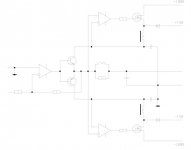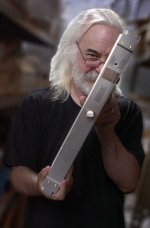Class D amplifiers would seem to represent an interesting yin to the yang of the First Watt amplifiers, occupying the other ends of the power and efficiency spectrums.
Wouldn’t it be interesting to see if some of the clever minds here could come up with some innovative design insights in the Class D realm?
Wouldn’t it be interesting to see if some of the clever minds here could come up with some innovative design insights in the Class D realm?
I was checking the date to make sure it wasn’t April 1st when I saw this post. [emoji23]
Class D is an interesting amplifier topology that sounds great and has a bright future but the complexity of its designs runs counter to First Watt’s principles.
Class D is an interesting amplifier topology that sounds great and has a bright future but the complexity of its designs runs counter to First Watt’s principles.
What a bomb to drop in the Pass forum, this should be interesting 😱 
Jokin' aside, I can (kind of) see your point..

Jokin' aside, I can (kind of) see your point..
Jokin' aside, I can (kind of) see your point..
Part of my thought is that philosophy doesn't necessarily equate to topology.
I can agree with that, but as you must be aware, Class D has a bad rep in High-fidelity circles, and not without good reason. Although I would imagine they have improved a lot over the last years.
Pass did experiment with class d or PWM amps about 5 or 10 years ago if I remeber correctly. Obviously, things have changed since then.
Nelson is a genius and makes some of the best amps in the world but class d is such a different animal...it’s almost like asking an airplane designer to design a helicopter. Yeah, it kind of does the same thing and he could probably do it but it’s different.
Also, class d is not really diy friendly. Layout is so important, smd parts, etc. It would be kind of like etching your own board for a computer.
Nelson is a genius and makes some of the best amps in the world but class d is such a different animal...it’s almost like asking an airplane designer to design a helicopter. Yeah, it kind of does the same thing and he could probably do it but it’s different.
Also, class d is not really diy friendly. Layout is so important, smd parts, etc. It would be kind of like etching your own board for a computer.
Class d is a minefield for beginners.
PCB layout is critical.
Decoupling correctly is critical.
Correct dead time is important.
Over current detect is vital to stop resetting.
I had trouble with a irs2092 design where on power down it would out a siren type noise for one second then give a massive thump through the speaker. IR said I had to much smoothing causing the 2092 to switch off badly. I fixed the problem with an a2d on VCC and a opto-coupler on the reset line all controlled by a small PIC micro.
PCB layout is critical.
Decoupling correctly is critical.
Correct dead time is important.
Over current detect is vital to stop resetting.
I had trouble with a irs2092 design where on power down it would out a siren type noise for one second then give a massive thump through the speaker. IR said I had to much smoothing causing the 2092 to switch off badly. I fixed the problem with an a2d on VCC and a opto-coupler on the reset line all controlled by a small PIC micro.
Pass did experiment with class d or PWM amps about 5 or 10 years ago if I remember correctly.
That was more like 30+ years ago. I still have that laying around here
somewhere.
That was more like 30+ years ago. I still have that laying around here
somewhere.
And dare I ask what you think of class D now?
Some of the higher priced offerings certainly compete at retail with Pass Labs products. And some manufacturers (Jeff Rowland, etc) have even switched their entire line from a/b to class d. It seems for the last 10 years or so people have been saying class d is the future but it hasn’t happened yet.
Noooooooooooooooooooo.
Hahaha
Sought of like putting triangular wheels on a car and designing complicated suspension just to compensate for the bad wheels.
Hahaha
Sought of like putting triangular wheels on a car and designing complicated suspension just to compensate for the bad wheels.
Yes, class d seems like an answer to a problem that doesn’t exist...Audiophiles don’t care about efficiency or size in general for or home systems.
On the other hand, I bet all of us listened to class d today by means of tv, computer, phone or something.
On the other hand, I bet all of us listened to class d today by means of tv, computer, phone or something.
Yes, class d seems like an answer to a problem that doesn’t exist...
It's cheap as chips?
That's a good point. It gets pretty expensive keeping a home cool enough for "class A" during a significant portion of the year here. I still use them nonetheless, because I suffer for my hobby!
I care about efficiency and would always prefer a smaller amplifier that doesn't general a lot of heat, all else equal.Yes, class d seems like an answer to a problem that doesn’t exist...Audiophiles don’t care about efficiency or size in general for or home systems.
A small Class A amp will work well for the upper frequencies of my speaker design.
I am currently designing a bass section. It will be a sealed unit with a Linkwitz Transform applied. I am going this way to save size as well as to be able to exert more control over the interactions between the room and the speaker. To generate low bass at my design SPL levels, I will need in excess of 1,000 watts. The driver I am using has a 1,700 watt AES power rating. A Class A amp would need a circuit suitable for a decent-sized ceramics kiln.
Sometimes there is an iterative problem/solution cycle, where technological advances in one area, say in driver design and manufacturing, create an opportunity for a solution with different constraints than existing mainstream solutions, such as new Class D implementations. The newly advanced solution might alleviate constraints that allow advancement in the first area, and so on.
I believe this happened with Top Fuel dragsters, for example. In drag racing, the limit of sensible power production is set, in the main, by the onset of wheelspin. Improved rubber compounds and traction control technology allowed the application of more power, driving engine technology, which in turned fueled advances in traction technology and so on.
Class D may not interesting to everyone, but it certainly addresses the needs of some audiophiles.
One might argue, by the way, that the First Watt SIT amps are an answer to a problem that doesn't exist. This isn't a view I share.
Last edited:
Just use a chipamp for bass, or multiples of in parallel for more power.
No need to make things complicated, especially for the power supplies, with Class A and D together.
Patrick
No need to make things complicated, especially for the power supplies, with Class A and D together.
Patrick
And dare I ask what you think of class D now?
Some of the higher priced offerings certainly compete at retail with Pass Labs products. And some manufacturers (Jeff Rowland, etc) have even switched their entire line from a/b to class d. It seems for the last 10 years or so people have been saying class d is the future but it hasn’t happened yet.
I began a reply, but then realized that I was about to say rude things about
people I like and respect.
- Status
- Not open for further replies.
- Home
- Amplifiers
- Pass Labs
- New Pass “Last Watt” Class D Amplifier?

